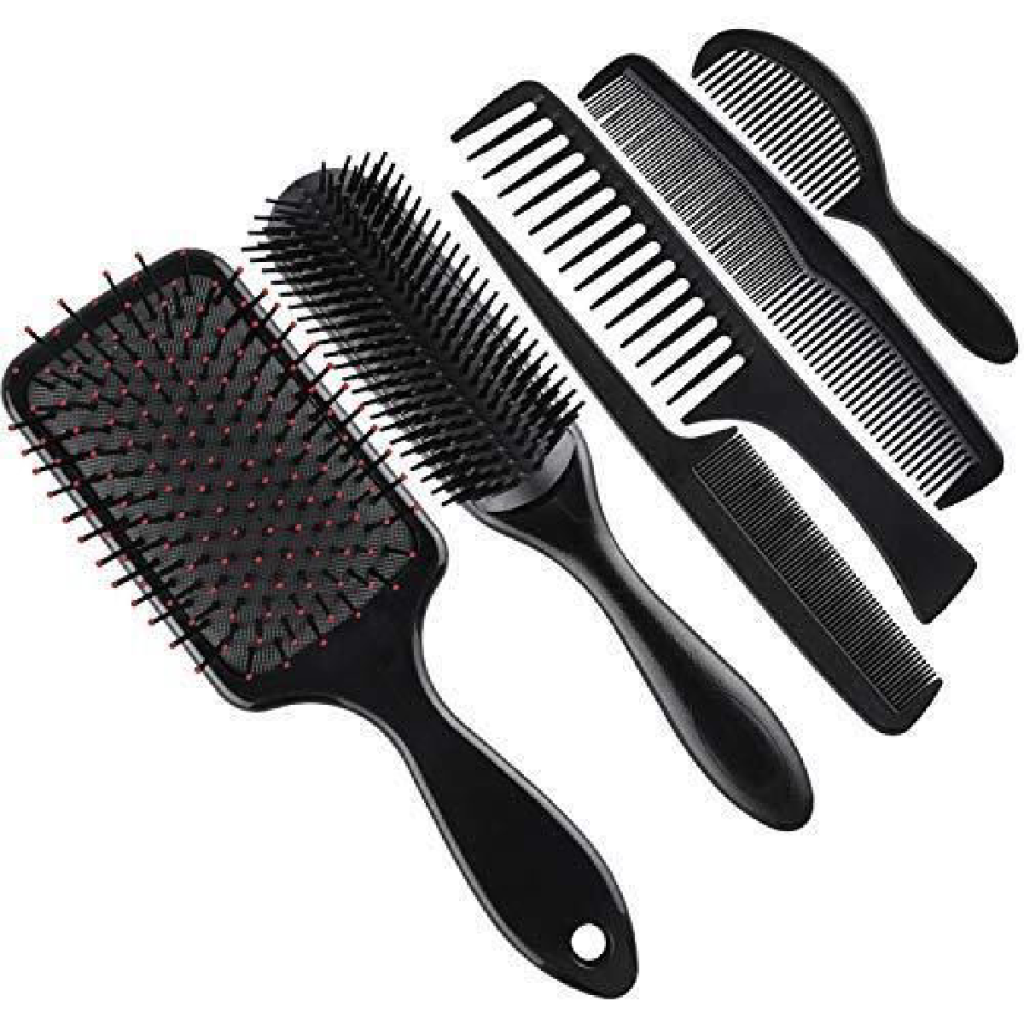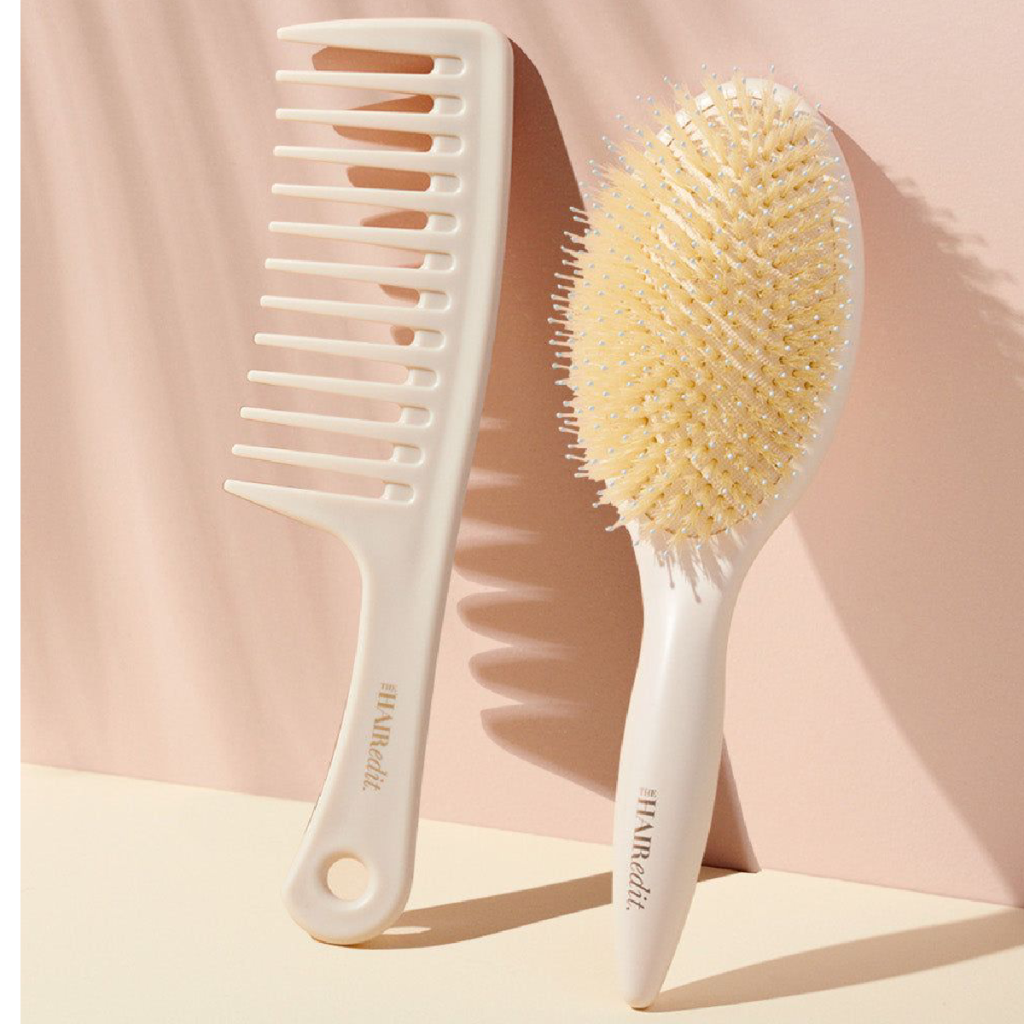Discover the key distinctions between detangling brushes and regular combs to achieve smoother, tangle-free hair.
Understanding the Difference Between Detangling Brushes and Regular Combs
When it comes to hair care, there seems to be an endless array of tools out there. Detangling brushes and regular combs are two staples that often find their way into our daily routines. But what exactly sets them apart? In this article, we’ll delve into the basics of these hair care tools, explore their design differences, uncover their functional disparities, and discuss the pros and cons of each. By the end, you’ll be equipped with the knowledge to choose the right tool for your hair type. Let’s dive in!

The Basics of Hair Care Tools
Before we dive into the world of detangling brushes and regular combs, let’s take a moment to understand the purpose of these hair care tools in general. They both serve the purpose of keeping our hair neat, tidy, and tangle-free. Now, let’s break it down further and explore each tool individually
What is a Detangling Brush?
A detangling brush, as the name suggests, is designed specifically to untangle knots and snarls in your hair. It typically features flexible bristles that glide through the hair effortlessly, gently detangling any knots along the way. These brushes are particularly popular among those with thick, curly, or easily tangled hair.
But here’s the game-changer: detangling brushes work their magic without causing pain or discomfort. No more yelps or tears during the detangling process! Isn’t that a breath of fresh air?
Imagine waking up with a head full of messy bedhead. You grab your detangling brush and start running it through your hair. With each stroke, the brush effortlessly glides through the knots, smoothing them out and restoring order to your locks. It’s like a gentle massage for your scalp, stimulating blood flow and promoting healthy hair growth.
Detangling brushes come in various shapes and sizes, catering to different hair types and needs. Some have longer bristles for tackling thicker hair, while others have shorter bristles for more delicate strands. There are even detangling brushes specifically designed for children, making hair care a breeze for parents.
What is a Regular Comb?
A regular comb, on the other hand, is a more traditional tool that serves various purposes beyond detangling. These combs usually have evenly spaced teeth made from materials like plastic, metal, or wood. Their primary function is to separate the hair strands and distribute natural oils evenly throughout the scalp, promoting healthy hair growth.
But wait, there’s more! Regular combs are not just for detangling and distributing oils. They are also great for styling and creating various hairdos. Whether you want a sleek ponytail, a bouncy blowout, or a chic updo, a regular comb can be your trusty companion.
Imagine getting ready for a special occasion. You have the perfect outfit, the flawless makeup, and now it’s time to style your hair. You reach for your regular comb and start sectioning your hair, creating the foundation for your desired hairstyle. With each stroke, the comb effortlessly glides through your hair, allowing you to mold and shape it into the perfect look.
Regular combs come in different sizes and styles to cater to different hair types and styling needs. Some have wider teeth for detangling and creating loose waves, while others have finer teeth for precise styling and intricate updos. The possibilities are endless!
The Design Differences
Now that we have a solid understanding of the basics, let’s turn our attention to the design differences between detangling brushes and regular combs. Understanding the structure of these tools will shed light on their unique functionalities.
Structure of a Detangling Brush
Detangling brushes often feature a wide head with bristles that vary in length. The bristles are usually made from nylon or other synthetic materials that are designed to be flexible and gentle on the hair. Some brushes even have specially designed bristles with rounded tips to further minimize potential damage or breakage.
The wide head of a detangling brush allows for a larger surface area to come into contact with your hair, making it easier to detangle knots and snarls. The varying lengths of the bristles ensure that the brush can effectively reach all areas of your hair, from the roots to the tips.
Additionally, the flexibility of the bristles allows them to bend and move with your hair, reducing the risk of pulling or tugging. This makes detangling brushes a great option for those with delicate or easily damaged hair.
The ergonomic handle of a detangling brush ensures a comfortable grip, allowing you to navigate through your hair with ease. With a detangling brush in hand, you’ll feel like a hair superhero!
Structure of a Regular Comb
Regular combs, on the other hand, have a more straightforward design. They typically consist of a long, slender handle with teeth evenly spaced along its length. The spacing between the teeth can vary, allowing for different degrees of hair separation and styling.
The simplicity of the regular comb’s design is what makes it a versatile tool for various hair types and styles. The evenly spaced teeth make it easy to glide through your hair, whether it’s thick or thin, curly or straight.
Some regular combs even come with additional features like a handle with a pointed end, perfect for sectioning the hair during styling. This allows for more precise and controlled movements, whether you’re creating a sleek updo or intricate braids.
Another variation of the regular comb is the wide-toothed design, which is ideal for detangling wet hair without causing unnecessary breakage. The wider gaps between the teeth allow for easier passage through damp strands, minimizing the risk of hair breakage or damage.
It’s safe to say that regular combs have got all your hair care needs covered. Whether you’re looking to detangle, style, or section your hair, a regular comb is a reliable and essential tool in your hair care arsenal.
The Functional Differences
Now that we’re familiar with the design aspects, it’s time to explore the functional differences between detangling brushes and regular combs. After all, understanding how these tools actually work is crucial in making an informed decision about which one is best suited for your hair.
How Does a Detangling Brush Work?
Detangling brushes work their magic through a combination of cleverly designed bristles and strategic brushing techniques. The flexible bristles gently glide through the hair, separating the strands and detangling knots as they go.
But let’s dive deeper into how these bristles actually work. The bristles of a detangling brush are usually made of various materials, such as nylon or boar bristles. These materials are chosen for their ability to flex and bend without causing damage to the hair. The bristles are strategically spaced apart to allow for easy movement through the hair, while still being close enough to detangle any knots or tangles.
As you brush your hair with a detangling brush, the bristles work their way through the strands, gently detangling any knots or snags along the way. The flexibility of the bristles allows them to bend and move with the hair, reducing the risk of breakage. This makes detangling brushes a great option for those with fragile or easily damaged hair.
The key to using a detangling brush effectively is to start from the ends of the hair and work your way up to the roots. This technique minimizes potential breakage and ensures a pain-free detangling experience. So, go ahead and enjoy the stress-free hair detangling session you deserve!
How Does a Regular Comb Work?
Regular combs, as multi-purpose tools, offer a slightly different approach to hair care. With evenly spaced teeth, regular combs excel at distributing natural oils, reducing static, and stimulating the scalp.
Let’s take a closer look at how these evenly spaced teeth contribute to the functionality of a regular comb. The teeth of a regular comb are designed to be closely packed together, allowing for a smooth and even distribution of natural oils from the scalp to the hair strands. This helps to keep the hair moisturized, nourished, and less prone to dryness or frizz.
In addition to distributing natural oils, regular combs also help to reduce static electricity in the hair. The even spacing of the teeth allows for a smooth passage through the hair, minimizing friction and preventing the build-up of static charge. This means you can say goodbye to those pesky flyaways and hello to sleek, smooth locks.
When using a regular comb, it’s best to start from the roots and work your way down to the ends in gentle strokes. This helps to distribute natural oils from the scalp to the hair tips, promoting overall hair health and shine. Say hello to a picture-perfect mane!
Pros and Cons of Detangling Brushes and Regular Combs
Now that we’re well-versed in the functionalities of detangling brushes and regular combs, let’s assess the pros and cons of each. After all, every tool has its strengths and weaknesses!

Benefits of Using a Detangling Brush
- No more pain or discomfort during the detangling process
- Effortlessly untangles knots and snarls
- Ideal for thick, curly, or easily tangled hair
Drawbacks of Using a Detangling Brush
- May not be suitable for very fine or thin hair
- Can cause excessive volume or frizz for certain hair types
- Requires more time and effort for thorough detangling
Benefits of Using a Regular Comb
- Multi-purpose tool for styling, sectioning, and teasing hair
- Promotes healthy hair growth by distributing natural oils
- Offers more versatility in terms of hairstyling options
Drawbacks of Using a Regular Comb
- Can be more prone to causing pain or discomfort
- Not as effective in detangling very knotted or tangled hair
- Limited benefits specific to detangling
Choosing the Right Tool for Your Hair Type
Now that we’ve covered the basics, design differences, functional disparities, and pros and cons, it’s time to tackle the ultimate question: Which tool is right for you?
Best Practices for Curly Hair
If you have curly hair, a detangling brush might be your new best friend. Its gentle bristles and pain-free detangling will make your curly locks sing with joy!
Start by applying a leave-in conditioner or detangling spray to soften the hair. Then, use your detangling brush in small sections, working from the ends to the roots. Embrace your beautiful curls, knowing that you’re giving them the care they deserve.
Best Practices for Straight Hair
Straight hair often benefits from the natural oil distribution that regular combs offer. Begin at the roots and use your regular comb to distribute the natural oils from your scalp to the tips. Revel in the smooth, glossy finish only a regular comb can provide.
Pro tip: To add some volume and texture, tease your hair gently using the fine teeth of your regular comb. Hello, gorgeous voluminous locks!
Best Practices for Wavy Hair
Wavy hair, like a delightful mix of straight and curly, can benefit from the best of both worlds. Start by using a regular comb to distribute natural oils and maintain a smooth appearance.
To bring out the natural waves, use a detangling brush in small sections, gently coaxing out any knots or tangles. Allow your waves to flow freely and make a splash wherever you go!
With the knowledge and understanding of both detangling brushes and regular combs, you’re now equipped to make an informed decision based on your hair type and specific needs. Embrace the power of hair care tools, unleash your creativity, and rock those fabulous locks with confidence!





